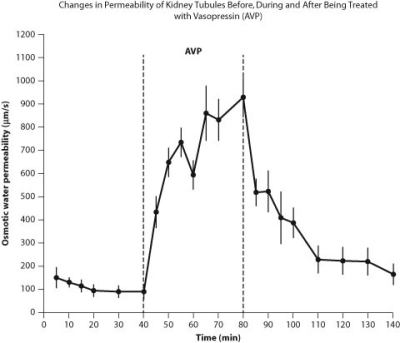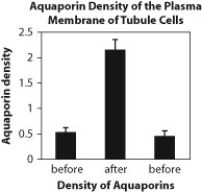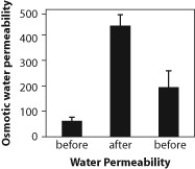Water movement is important in urine formation in the kidneys. Urine is formed when the blood is filtered by the kidneys into kidney tubules. Three figures are presented here that relate to how the kidney tubules respond to the administration of the hormone vasopressin. The direction that water flows in these figures is from the kidney tubules back into the blood.
 Figure A. Changes in permeability of tubules in the kidney in response to the hormone vasopressin (AVP) , which aids in osmoregulation.
Figure A. Changes in permeability of tubules in the kidney in response to the hormone vasopressin (AVP) , which aids in osmoregulation.
 Figure B. Density of aquaporins in kidney tubule cells before, during, and after administration of vasopressin.
Figure B. Density of aquaporins in kidney tubule cells before, during, and after administration of vasopressin.
 Figure C. Permeability of tissues to water before, during, and after administration of vasopressin.
Figure C. Permeability of tissues to water before, during, and after administration of vasopressin.
-Based on the data from these figures, what do you expect the urine of a person to be like when vasopressin is having an effect on the kidney tubules?
Definitions:
Attribute
A quality or feature regarded as a characteristic or inherent part of someone or something.
Social Influence
An interaction process in which one person’s behavior causes another person to change an opinion or to perform an action that he or she would not otherwise do.
Influence
The capacity to have an effect on the character, development, or behavior of someone or something.
Effectiveness
The degree to which objectives are achieved and the extent to which targeted problems are solved, in various contexts including business, therapy, and medicine.
Q6: A bullet is fired straight down from
Q9: What term refers to seasonal changes in
Q9: Which is an example of a population?<br>A)
Q22: If a chromosome fragment breaks off and
Q22: Interpret the age structure diagram for jackals
Q25: Which of the following cells has the
Q32: Some friends are trying to make wine
Q62: For water transport in vascular plants, the
Q63: The alleles of a gene are found
Q88: Which of the following structures is/are used